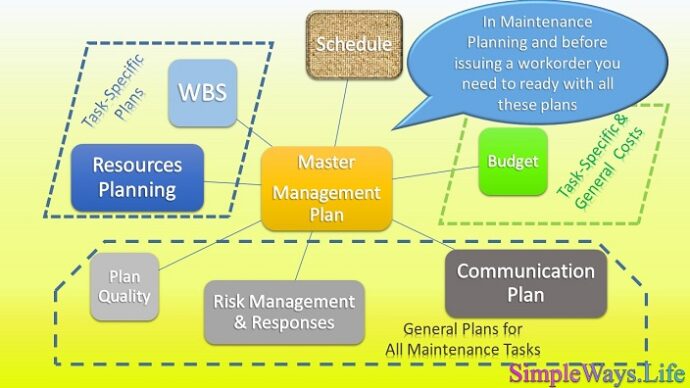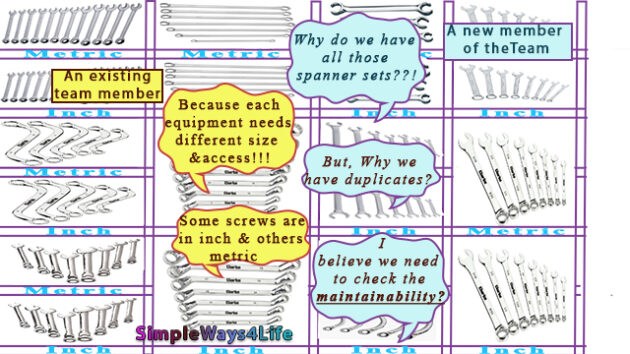The straight forward perception of managing execution is to properly use the resources or assets to produce the desired output. In the real world there is a lot of other functionalities to manage to reach the desired output. Those other aside but crucial functions brings a lot of gems to the process and to the maintenance or the project manager himself.
It is not the direct usage of the resources that brings the desired output. But, it is managing the resources and giving back to it that land the project or maintenance execution on the right destination.
What do maintenance managers manage?
Maintenance managers do not only manage the doing part. In other words the wrench-time. Actually they manage the team, the documents, the plans, the suppliers and the risks. They utilize them while at the same time add to and update them.
Manage your team
Managing the team, doesn’t mean calculate their wrench-time and let them do more for less. Or even schedule their time and skills to synchronize with the maintenance schedule. Team management has another side that is totally unspoken about. It is managing their human needs. Human needs follow Maslow’s pyramid of needs. So they have some basic physiological needs. And, they need safety, socializing , esteem and, self actualization. You can read more details about it in this post: Manager’s role to support the hierarchy of needs.
On the top of the human needs comes the self esteem either from you as a manger or from their trust in their own capabilities. This will lead them to the pyramid pinnacle which is self motivation to reach self actualization. You can lead your team to those last steps through upgrading their capabilities so they can match your expectation. This statement has two (2) sides.
Your expectation; that’s your vision of the professionality of team performance. Normally your team can’t exceed your expectation for them. It is like that you are placing a ceiling on how far they can grow. Also, If you don’t know the horizon of their skills, you won’t be able to open a space for them to go there.
The team capabilities, this doesn’t imply only enrolling them in an official training even though it is one of the good alternatives. There are some basic skills like time management, communication skills and passing them some of your technical knowledge. Also, you can delegate them some tasks and teach them to practice delegation. Those soft skills has tremendous effect on your team.
Manage the suppliers
Suppliers who are external to the organization, especially those you are dealing with for the first time, need to receive clear technical and time schedule requirements. And, on the other hand try to accept only clear offers, commitments and schedules. Then, comes the follow up. Make sure to include in your requirements and in the supplier’s offer some milestones that confirm that your goods, tools, or whatever you are procuring will be ready on time and in the agreed quality. This can be supplier workshop inspection or even photo or shipping schedule, etc.
Manage the documents
As we said, the theme of this article is that managing the execution doesn’t mean to use the resources to produce the output but to give back to the resources as a part of managing them. Same philosophy applies to the documents. There are a lot of documents that are crucial for the success of the execution process of any task. Among those documents comes the management plans, the schedule, the safety or the risk records, the SOPs -simply task procedures and standards-, the technical drawings needed, the execution feedback and, the lessons learned – if adopted-.
There are two (2) ways of giving back. The first one is filling and filing the feedback and lessons learned. The other one is the updating of those documents. The updating process of the documents might seem an effort-wasting job or might be ignored as we all know what need to be done which is different from what is written. That’s need an effective change management process.
Change management
That’s one of the important management plans in project management which we usually overlook in the maintenance process. Project management had standardized the process of changing any of the project output or plans. The change process includes reviewing all change requests, approving or rejecting changes. Then, amending the deliverables, organizational process assets, project documents and the project management plans. The target is to have the approved changes documented as clear as the original plans so we are all working on the correct page. Also, the rejected changes to be clear so no one deem a change is approved once it is submitted and starts to act upon.
All this will be clear when we chat around the control group of processes which go hand-in-hand with the execution process.
Lastly, manage the work execution environment
We didn’t say that the maintenance manager needs to manage the business environment but at least the local environment his team works in. The business environment includes the internal and external factors that effect the business in general. You can find some examples in the national regulations, the organization yearly targets, the competitors, the consumers aptitude, global issues like inflation, unrest or similar issues. Even though as a maintenance manger, you can’t control those issues but at least you want to create a temporary safe heaven for your team during executing their tasks. Even allowing some margin to discuss those global business environmental factors can ease the tension imposed on the workplace.
The more tangible effort from the maintenance manager can be found in creating a safe, supportive and respectful workplace. Those terms are general ones but their true meaning can be found in each workplace individually. What do support means to your team? Does it mean to offload the heavy muscle load by procuring lifting tools? Does it imply new set of hand tools? May be technical support? It can be free expression of their confusion or disagreement about a task?
A Project management reference For how to Direct and manage Project execution
PMBook says:
- Direct and Manage Project Execution is the process of performing the work defined in the project
- management plan to achieve the project’s objectives. These activities include, but are not limited to:
- Perform activities to accomplish project requirements;
- Create project deliverables;
- Staff, train, and manage the team members assigned to the project;
- Obtain, manage, and use resources including materials, tools, equipment, and facilities;
- Implement the planned methods and standards;
- Establish and manage project communication channels, both external and internal to the project team;
- Generate project data, such as cost, schedule, technical and quality progress, and status to facilitate
- forecasting;
- Issue change requests and adapt approved changes into the project’s scope, plans, and environment;
- Manage risks and implement risk response activities;
- Manage sellers and suppliers; and
- Collect and document lessons learned, and implement approved process improvement activities.
The execution process includes
Inputs:
- Project management plan
- Approved change requests
- Enterprise environmental factors
- Organizational process assets
Tools & Techniques
- Expert judgment
- Project management
- information system
Outputs
- Deliverables
- Work performance information
- Change requests
- Project management plan updates
- Project document updates
In conclusion,
The manager role has more than just the mere management of doing the job. There is a lot of other streams to manage. A maintenance manager need to balance the giving back to the team, the suppliers, the documents and the business environment. It is not a one way relationship that he takes all what is needed to execute the job without giving back.
If you feel you need help with any of these ideas we discussed, request a Management Consultancy or Coaching Services From our Store









One Comment